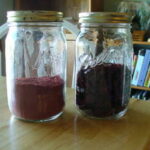You have decided that you would like the convenience, the (possible) cost-savings, and the (likely) nutritional boost from adding a fruit tree to your home garden. You already have a pleasant picture of yourself plucking a ripe fruit, taking a big juicy bite, and savoring the taste.
Now back to reality.
Your first choice is type of fruit tree. What fruit does your family eat?
If nobody in your family eats plums fresh, preferring plum jelly or plum sauce, unless your the type who enjoys canning and cooking up a storm you should avoid planting a full-sized plum tree in your backyard.
If the fuzz on a peach’s skin forces you to peel it before offering slices to your significant other, perhaps plunking down a freestone varietal in the sideyard would be a poor decision.
But think about crossing the smooth skin from a plum with the flavor of a peach: a nectarine tree (Prunus persica nucipersica), dwarf or full-sized, may be just the fruit tree for you.
Before running out a buying whatever nectarine tree you first find in the garden department at the local home improvement warehouse, you should do a bit of research either online or on-dead-tree. What variety of nectarine best suits your locality?
Nectarine trees are persnickety about temperature, preferring a middling range of cool (not cold) winters and warm (not cool) summers. Depending on the particular variety, they require between 350 and 1200 hours of cold temperatures during winter dormancy. But you don’t have to worry about providing a source of cross-pollination, because nectarine trees self-pollinate as long as there are bees and wasps visiting their blossoms.
Possible diseases should weigh in when considering which particular variety to chose. When reading labels at the garden department or nursery, watch for varieties resistant to such diseases as leaf curl, brown rot, bacterial canker and bacterial leaf spot.
Once you’ve chosen your nectarine tree and planted it in well-drained sandy loamy soil with the bud union an inch or so above the soil, your work isn’t over. Keep it well-fed (a balanced 10-10-10 fertilizer spread evenly away from the trunk) and watered, and prune it annually. Nectarine trees bear fruit on the previous year’s growth. Pruning should remove up to two-thirds of that growth to renew the fruiting wood.
Nectarine trees bear fruit abundantly. To prevent damage to the trees limbs, and to promote good-sized fruit, the year’s developing crop should be thinned once the fruit reaches about an inch in diameter, spacing remaining fruit about seven to nine inches apart.
Because nectarines go dormant in winter, dropping their leaves, a dormant spray is recommended twice a year, once in the fall shortly after the leaves have dropped, and once again before spring brings out buds. A dormant spray made up of a mixture of Volck oil and lime sulphur will help to control overwintering mites and insects by smothering them, plus help to prevent leaf curl by killing the fungus responsible for the disease.
Tend your new nectarine tree properly and you’ll soon be living that pleasant picture.
Additional Resources:
Nectarines Nutrition Facts” Associated Content. URL: (http://freshcutproduce.com/nutrifax/nectarines.html)
Gary Gao. “Growing Peaches and Nectarines” Associated Content. URL: (http://ohioline.osu.edu/hyg-fact/1000/1406.html)
Rosie Lerner. “Nectarine – Tree” Associated Content. URL: (http://www.hort.purdue.edu/ext/senior/fruits/nectarine2.htm)





